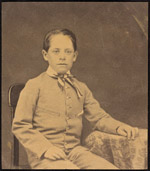Photographic Processes: 1839 – 1889
SALTED PAPER PRINT (salt print), 1840-1870s
Silver-based paper print without a binder, usually printed from either paper or glass negatives
Paper is brushed with a salt solution, dried, and brushed with a silver nitrate solution to form light sensitive silver halide. The sensitized paper is placed in direct and tight contact with a negative and exposed to light. The image appears during the exposure, a process commonly known as “printing-out.” The prints are then washed and fixed in hypo (sodium thiosulfate) to halt further image formation.
The newly made salted paper print has warm brown to purplish-brown image tones. However, the silver image of the salted paper print is prone to oxidation, resulting in fading and a shift to ochre tones.
 |
Unidentified. Salted Paper Print, ca. 1849. [zoom] 4 7/8 x 4 1/4 in. On loan from the Stephan and Beth Loewentheil Family Photographic Collection. |